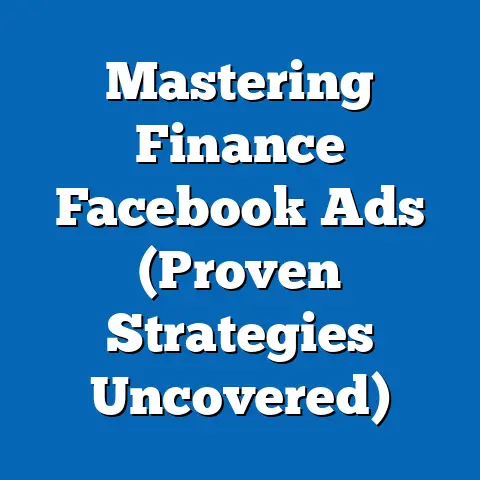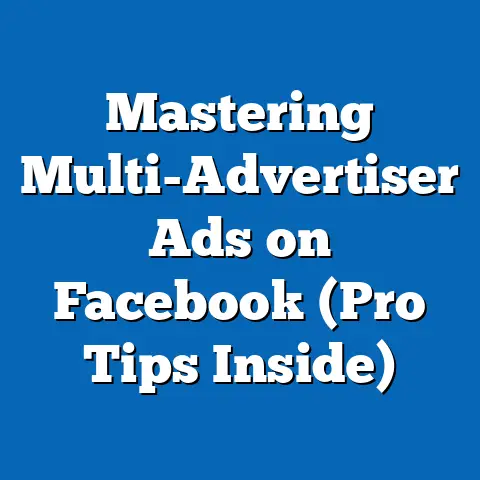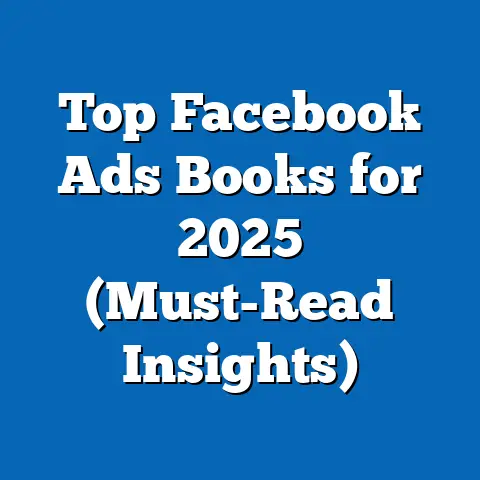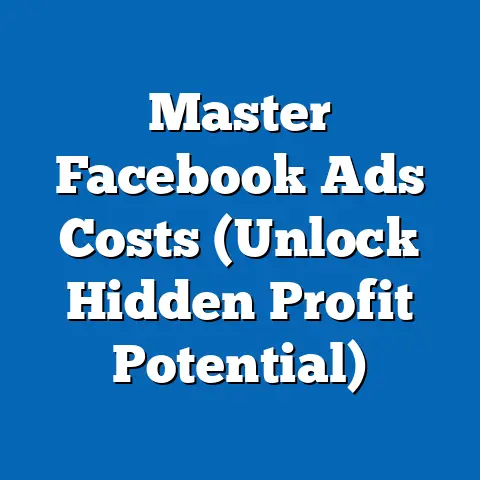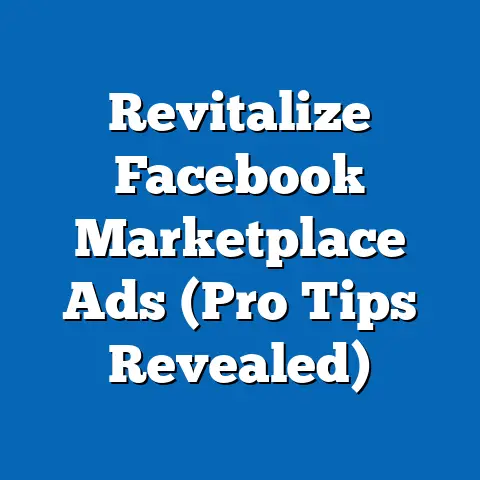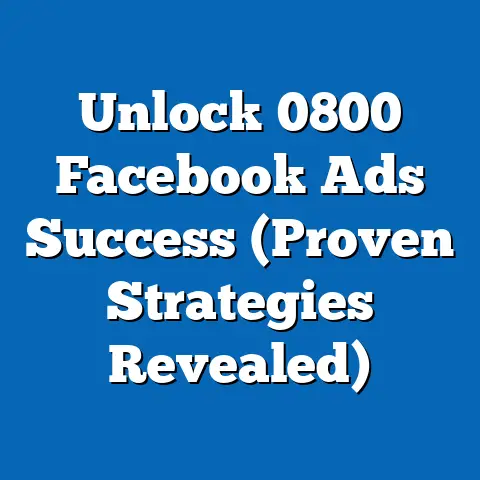Decode Facebook Ads Ambiguities (Expert Insights)
Have you ever shopped for something waterproof? I have, countless times! You’re bombarded with options, each promising ultimate protection. But then you see terms like “water-resistant,” “waterproof,” “IP67,” and you’re left wondering, “What does it really mean?” It’s the same feeling I get when diving into Facebook Ads.
Facebook advertising, much like shopping for truly waterproof gear, is rife with potential pitfalls and hidden complexities. We’re promised targeted reach, high conversion rates, and measurable ROI, but the reality is often a tangled web of metrics, algorithm changes, and ever-evolving best practices. Just as a misleading “waterproof” label can lead to a soggy phone, misunderstandings in Facebook Ads can lead to wasted ad spend and disappointing results.
Understanding these ambiguities is crucial. It’s the difference between confidently navigating the waters of digital marketing and getting completely submerged. This guide is designed to shed light on these complexities, offering expert insights and actionable strategies to help you optimize your Facebook ad performance and achieve your desired marketing outcomes. Let’s dive in!
Understanding the Basics of Facebook Ads
Facebook Ads, at its core, allows businesses to connect with a highly targeted audience on the world’s largest social media platform. The power lies in its granular targeting capabilities and diverse ad formats.
Here’s a quick overview of some common ad formats:
- Image Ads: Simple, visually appealing ads with a single image and concise copy. Great for showcasing products or services with strong visuals.
- Video Ads: Engaging ads that capture attention through motion and sound. Ideal for storytelling, product demos, or behind-the-scenes glimpses.
- Carousel Ads: Allow users to scroll through multiple images or videos in a single ad unit. Perfect for showcasing a range of products or highlighting different features.
- Collection Ads: Designed for mobile shoppers, these ads feature a hero image or video followed by a selection of products. Streamlines the path to purchase.
Each campaign is built upon these key components:
- Objectives: What do you want to achieve? Increased website traffic, lead generation, brand awareness, or sales? Defining your objective is the first and most crucial step.
- Targeting: Who do you want to reach? Facebook’s targeting options are incredibly detailed, allowing you to define your audience based on demographics, interests, behaviors, and more.
- Creative: The visual and textual elements of your ad. This includes images, videos, ad copy, and calls to action. Compelling creative is essential for capturing attention and driving engagement.
- Budget: How much are you willing to spend? You can set daily or lifetime budgets and choose between different bidding strategies to optimize your spend.
But here’s where the ambiguity creeps in. Even with a clear objective, carefully crafted creative, and a well-defined budget, success isn’t guaranteed. Performance metrics can be misleading, audience insights can be difficult to interpret, and algorithm changes can throw your entire strategy into disarray. This inherent uncertainty is what makes Facebook Ads both powerful and challenging.
Takeaway: Understanding the core components of Facebook Ads is essential, but recognize that success requires more than just following the steps. It requires critical thinking, data analysis, and a willingness to adapt to the ever-changing landscape.
Common Ambiguities in Facebook Ads
I’ve seen firsthand how easily marketers can be tripped up by the ambiguities inherent in Facebook Ads. Here are some of the most common pitfalls I’ve encountered:
-
Misinterpretation of Performance Metrics:
- The Ambiguity: Metrics like click-through rate (CTR) and cost per click (CPC) are often touted as key indicators of ad performance. However, focusing solely on these metrics can be misleading. A high CTR doesn’t necessarily translate to conversions or sales.
- The Reality: A catchy ad can generate clicks, but if the landing page is irrelevant or the offer isn’t compelling, those clicks are essentially wasted. Similarly, a low CPC might seem like a win, but if the traffic isn’t qualified, it won’t contribute to your bottom line.
- Example: I once worked with a client who was thrilled with their high CTR, but their conversion rate was abysmal. After digging deeper, we realized their ad copy was slightly misleading, attracting clicks from users who weren’t actually interested in their product.
- The Solution: Focus on metrics that directly correlate with your business goals, such as conversion rate, cost per acquisition (CPA), and return on ad spend (ROAS). These metrics provide a more accurate picture of your ad’s effectiveness.
-
Differences in Audience Targeting Options:
- The Ambiguity: Facebook offers a vast array of targeting options, from demographics and interests to behaviors and custom audiences. However, choosing the right targeting options can be overwhelming, and relying on broad targeting can lead to wasted ad spend.
- The Reality: Selecting the wrong targeting options can result in reaching an audience that is either too broad (resulting in low engagement) or too narrow (limiting your reach and potential conversions).
- Example: A client selling high-end cycling equipment initially targeted users interested in “cycling.” While this seemed logical, it included casual cyclists who weren’t their target market. By refining their targeting to include users interested in specific cycling brands and events, they significantly improved their conversion rate.
- The Solution: Conduct thorough audience research to understand your ideal customer’s demographics, interests, and behaviors. Experiment with different targeting options, including lookalike audiences and custom audiences based on your existing customer data. Continuously refine your targeting based on performance data.
-
The Impact of Algorithm Changes:
- The Ambiguity: Facebook’s algorithm is constantly evolving, and these changes can have a significant impact on ad visibility and performance. What worked yesterday might not work today.
- The Reality: Algorithm updates can affect ad delivery, targeting accuracy, and even the cost of advertising. Staying ahead of these changes is crucial for maintaining a competitive edge.
- Example: I remember when Facebook prioritized “meaningful interactions” in its algorithm. Suddenly, ads that focused solely on driving clicks saw a significant drop in performance. We had to shift our strategy to create more engaging content that fostered conversations and built relationships.
- The Solution: Stay informed about Facebook’s algorithm changes by following industry blogs, attending webinars, and engaging with the Facebook Ads community. Be prepared to adapt your strategy quickly based on these changes.
Misinterpretation of Performance Metrics:
- The Ambiguity: Metrics like click-through rate (CTR) and cost per click (CPC) are often touted as key indicators of ad performance. However, focusing solely on these metrics can be misleading. A high CTR doesn’t necessarily translate to conversions or sales.
- The Reality: A catchy ad can generate clicks, but if the landing page is irrelevant or the offer isn’t compelling, those clicks are essentially wasted. Similarly, a low CPC might seem like a win, but if the traffic isn’t qualified, it won’t contribute to your bottom line.
- Example: I once worked with a client who was thrilled with their high CTR, but their conversion rate was abysmal. After digging deeper, we realized their ad copy was slightly misleading, attracting clicks from users who weren’t actually interested in their product.
- The Solution: Focus on metrics that directly correlate with your business goals, such as conversion rate, cost per acquisition (CPA), and return on ad spend (ROAS). These metrics provide a more accurate picture of your ad’s effectiveness.
Differences in Audience Targeting Options:
- The Ambiguity: Facebook offers a vast array of targeting options, from demographics and interests to behaviors and custom audiences. However, choosing the right targeting options can be overwhelming, and relying on broad targeting can lead to wasted ad spend.
- The Reality: Selecting the wrong targeting options can result in reaching an audience that is either too broad (resulting in low engagement) or too narrow (limiting your reach and potential conversions).
- Example: A client selling high-end cycling equipment initially targeted users interested in “cycling.” While this seemed logical, it included casual cyclists who weren’t their target market. By refining their targeting to include users interested in specific cycling brands and events, they significantly improved their conversion rate.
- The Solution: Conduct thorough audience research to understand your ideal customer’s demographics, interests, and behaviors. Experiment with different targeting options, including lookalike audiences and custom audiences based on your existing customer data. Continuously refine your targeting based on performance data.
The Impact of Algorithm Changes:
- The Ambiguity: Facebook’s algorithm is constantly evolving, and these changes can have a significant impact on ad visibility and performance. What worked yesterday might not work today.
- The Reality: Algorithm updates can affect ad delivery, targeting accuracy, and even the cost of advertising. Staying ahead of these changes is crucial for maintaining a competitive edge.
- Example: I remember when Facebook prioritized “meaningful interactions” in its algorithm. Suddenly, ads that focused solely on driving clicks saw a significant drop in performance. We had to shift our strategy to create more engaging content that fostered conversations and built relationships.
- The Solution: Stay informed about Facebook’s algorithm changes by following industry blogs, attending webinars, and engaging with the Facebook Ads community. Be prepared to adapt your strategy quickly based on these changes.
Takeaway: Recognizing these common ambiguities is the first step towards navigating them effectively. Don’t rely on surface-level metrics or assumptions. Dig deeper, experiment, and stay informed.
Expert Insights on Navigating Ambiguities
To truly master Facebook Ads, I believe it’s crucial to learn from the experiences of seasoned marketers. I’ve spoken with several industry experts and gathered their insights on navigating the ambiguities of the platform. Here are some key takeaways:
-
“Data is your compass, but intuition is your map.” – Sarah Jones, Digital Marketing Consultant
Sarah emphasizes the importance of analyzing data to understand what’s working and what’s not. However, she also stresses the role of intuition and creative thinking in developing effective ad campaigns. “Data can tell you what happened, but it can’t tell you why. That’s where your intuition comes in. You need to be able to connect the dots and develop hypotheses based on your understanding of your audience and the market.”
-
“Never stop testing. Facebook is a moving target.” – David Lee, Founder of a Digital Marketing Agency
David highlights the importance of continuous testing and experimentation. “Facebook is constantly evolving, so what worked last month might not work this month. You need to be constantly testing different ad formats, targeting options, and creative approaches to stay ahead of the curve.” He recommends using A/B testing to compare different variations of your ads and identify the most effective strategies.
-
“Focus on providing value, not just selling.” – Emily Chen, Social Media Manager
Emily believes that the key to success on Facebook is to focus on providing value to your audience. “People are on Facebook to connect with friends and family, not to be bombarded with ads. If you want to capture their attention, you need to offer something valuable, whether it’s informative content, entertaining videos, or exclusive deals.” She recommends creating content that resonates with your target audience and builds a strong relationship with them.
-
“Embrace the complexity. There’s no magic bullet.” – Mark Brown, Facebook Ads Specialist
Mark acknowledges the complexity of Facebook Ads and warns against seeking quick fixes or magic bullets. “There’s no one-size-fits-all solution. What works for one business might not work for another. You need to be willing to put in the time and effort to understand your audience, experiment with different strategies, and continuously optimize your campaigns.”
“Data is your compass, but intuition is your map.” – Sarah Jones, Digital Marketing Consultant
Sarah emphasizes the importance of analyzing data to understand what’s working and what’s not. However, she also stresses the role of intuition and creative thinking in developing effective ad campaigns. “Data can tell you what happened, but it can’t tell you why. That’s where your intuition comes in. You need to be able to connect the dots and develop hypotheses based on your understanding of your audience and the market.”
“Never stop testing. Facebook is a moving target.” – David Lee, Founder of a Digital Marketing Agency
David highlights the importance of continuous testing and experimentation. “Facebook is constantly evolving, so what worked last month might not work this month. You need to be constantly testing different ad formats, targeting options, and creative approaches to stay ahead of the curve.” He recommends using A/B testing to compare different variations of your ads and identify the most effective strategies.
“Focus on providing value, not just selling.” – Emily Chen, Social Media Manager
Emily believes that the key to success on Facebook is to focus on providing value to your audience. “People are on Facebook to connect with friends and family, not to be bombarded with ads. If you want to capture their attention, you need to offer something valuable, whether it’s informative content, entertaining videos, or exclusive deals.” She recommends creating content that resonates with your target audience and builds a strong relationship with them.
“Embrace the complexity. There’s no magic bullet.” – Mark Brown, Facebook Ads Specialist
Mark acknowledges the complexity of Facebook Ads and warns against seeking quick fixes or magic bullets. “There’s no one-size-fits-all solution. What works for one business might not work for another. You need to be willing to put in the time and effort to understand your audience, experiment with different strategies, and continuously optimize your campaigns.”
Key Strategies for Interpreting Data Accurately:
- Regularly Review and Analyze Ad Performance: Set aside time each week (or even daily) to review your ad performance. Look beyond surface-level metrics and dig deeper into the data. Identify trends, patterns, and areas for improvement.
- Stay Updated with Facebook’s Algorithm Changes and Advertising Policies: Subscribe to industry blogs, follow Facebook’s official announcements, and attend webinars to stay informed about the latest changes.
- Utilize Facebook’s Own Resources: Facebook offers a wealth of resources, including the Ads Help Center, Business Manager tools, and Facebook Blueprint courses. Take advantage of these resources to enhance your knowledge and skills.
Takeaway: Learning from the experiences of industry experts can provide valuable insights and guidance. Embrace a mindset of continuous learning, experimentation, and adaptation to navigate the ambiguities of Facebook Ads effectively.
Case Studies and Real-World Applications
Let’s look at a couple of real-world examples of businesses that successfully navigated Facebook Ads ambiguities and improved their ad performance:
Case Study 1: Local Restaurant Improves Conversion Rate by Refining Targeting
- Challenge: A local restaurant was running Facebook Ads to drive reservations, but their conversion rate was low. They were targeting a broad audience within a 10-mile radius.
- Solution: They refined their targeting based on demographics, interests, and behaviors. They targeted users interested in specific cuisines, dining out, and local events. They also created a custom audience based on their existing customer list.
- Results: Their conversion rate increased by 50%, and their cost per acquisition decreased by 30%.
- Lesson Learned: Refining your targeting based on audience research can significantly improve your ad performance.
Case Study 2: E-commerce Store Adapts to Algorithm Change by Focusing on Engagement
- Challenge: An e-commerce store saw a significant drop in ad performance after Facebook prioritized “meaningful interactions” in its algorithm.
- Solution: They shifted their strategy to create more engaging content that fostered conversations and built relationships. They started running contests, asking questions, and sharing behind-the-scenes glimpses of their business.
- Results: Their engagement rate increased by 40%, and their ad performance rebounded.
- Lesson Learned: Adapting your strategy to algorithm changes is crucial for maintaining a competitive edge. Focus on providing value and building relationships with your audience.
Takeaway: These case studies demonstrate the importance of understanding the ambiguities of Facebook Ads and adapting your strategy based on data and insights.
Conclusion
Navigating the world of Facebook Ads can feel like wading through murky waters. Just as consumers need to carefully evaluate waterproof options to protect their belongings, marketers must diligently analyze and understand the intricacies of Facebook Ads to drive successful campaigns.
The key takeaways from this guide are:
- Recognize the common ambiguities in Facebook Ads, such as misinterpreting performance metrics, choosing the wrong targeting options, and adapting to algorithm changes.
- Learn from the experiences of industry experts and seasoned marketers.
- Embrace a mindset of continuous learning, experimentation, and adaptation.
- Focus on providing value to your audience and building strong relationships.
Clarity often comes with experience and persistence. Embrace a mindset of curiosity and continuous improvement in your advertising efforts, and you’ll be well on your way to mastering the art of Facebook Ads.
Now, go out there and make some waves!

